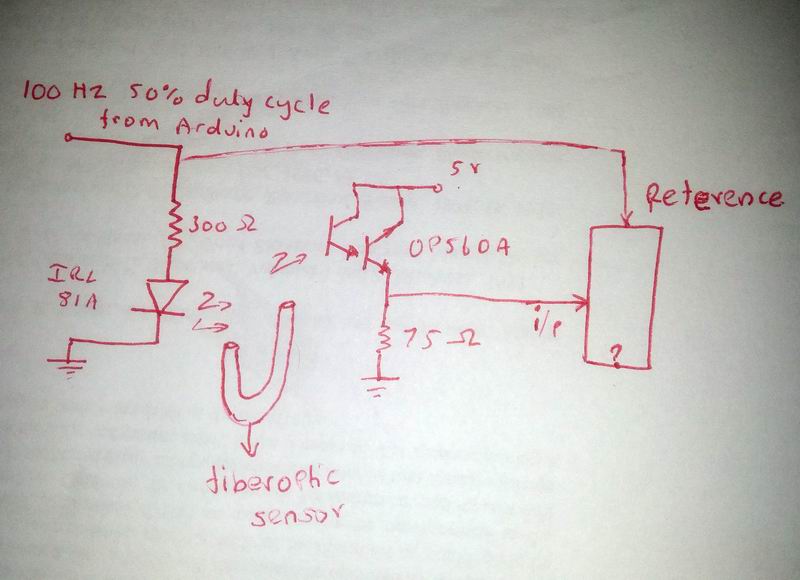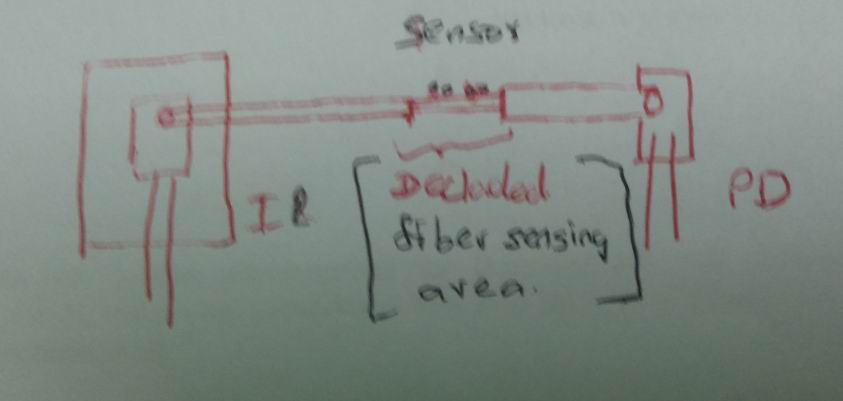lock in amplifier for IR LED and Photo darlington

i need a simple lock in amplifier for my circuit i used 555 timer with 1khz to irl81a and photodarlington op560c
doo i need any non inverting amplifier for my photodarlington output?
A lock-in amplifier or synchronous detector is a simple AC-coupled opamp with a key operated from your refetence source (555). There are many good versions available, check google. Analog Devices offers one IC designed as the sync detector but is expensive. I used a LM324 quad opamp with CD4016 or CD4066 quad key in my circuits.
After your darlington some AC gain amplifier may be needed: what is the 1 kHz signal range at its output?
Did you check if a synchronous rectifier is actually required for your measurement application? A simple AC measurement may do as well?
If you are attempting any quantitative optical measurement, a photodiode should be used instead of a phototransistor, because the transistor is very nonlinear and has temperature-dependent sensitivity.
http://www.digikey.com/product-detai...ADZ-ND/1643566 shall i use this one AD630ADZ.
i am using optical fiber so side viewer photodarlington has to be used to couple with optic fiber.
and i made a mistake this PD will work on 100hz only i will update and let you know
I have updated my circuits and waiting for your valuable comments
Your schematic looks OK. What is the signal range at photodiode output?
For start you can also use an audio millivolltmeter connected to photodiode or opamp output.
Hi,
a more detailed schematic of your photodiode circit would be good.
do you use an ADC and microcontroller to process the data?
Klaus
i am using +15 and -15 V to bias opamp shows good results. But i have to make a device to work on 5volt
i have attached so for i did and spec sheet of IR and Photo detector.
need more guidance regarding circuit whether i am going in a correct way
You can't use AD630 or LM741 with 5V single supply. Also the amplifier circuits must be biased differently for single supply operation.
Hi,
don′t use the old 741 opamp. There are way better opamps.
Use lower ohmic resistors for both OPAMPs. Like 1k / 10k (lower noise, more speed)
**
To make it work on +5V only supply, at first step you could add a 10k to your photodarlington in parallel. This lifts up the 100R voltage to 50mV.
This is enough for a Rail to Rail I/O OPAMP. It should generate no disadvantage.
If the DC makes problems you need to supress it.
Klaus
Instead of the AD630, you can use a "sign-multiplier" made by an OP and an analog switch. https://www.edaboard.com/thread272103.html
What's your motivation for using asymmetrical (10%) duty cycle?
i want to detect small change in refractive index of water when 0.1mg of sugar is added
duty cycle i am not quite sure about it,, shall i use 50%. let me try signmultiplier will it good in small change in detection with accurate and less noise compared to lockin?
@Klaus
thanks for the reply sir. i will try your method. could you suggest me a good opamp
The "signa multiplier" does essentially the same as AD630. There should be no difference in noise behaviour.
It's not bad to pulse the LED with 10 % duty cycle, but using the 10% duty cycle signal as reference for the synchronous demodulator will hardly give optimal signal-to-noise ratio. A straightforward scheme filters the 100 Hz fundamental before the synchronous demodulator and uses a 50 % duty cycle reference.
Hi,
Good Opamp:
There are so many around. And almost every is better than 741.
Look for RR I/O, specified with single 5V supply, GBW > 500kHz.
Klaus
OPA2137 http://www.ti.com/lit/ds/symlink/opa137.pdf
OPA703PA http://www.ti.com/lit/ds/symlink/opa703.pdf
which opamp is recommended?
http://www.wayjun.net/index.php?main...products_id=26 shall i use this after photo detector?
concept:
I use IRL81[LED] as source of 1KHZ 50% duty cycle PWM and OP560A[photodarlington] as Photo detector .
Connecting source and detector via Fiberoptic with small Portion decladded where different samples to be introduced.
When samples introduces in the decladed fiber there is a Changes in intensity. This change in intensity changes the Photo Darlington(PD) voltage
now i need to find the difference between the reference signal 1khz 50% duty cycle PWM and PD.
prob:
Need to detect change in amplitude as well as phase.
Working model: i used 1khz 50% duty cycle(don't get confused as shown in Image 100hz)


continuation of previous post
Hi,
Look for "lockin amplifier".
For phase detect I recommend to generate a second 50% duty cycle signal but withexactely 90° phase shift.
(Easy with a PLD with twice the input frequency).
Use this signal as reference for a second lockin amplifier.
With the output signals of both lockin amplifiers you can calculate amplitude as well as phase shift.
Klaus
exactely 90° phase shift. (Easy with a PLD with twice the input frequency).
could you help me with the circuit for 90 phase shift of 1khz 50% duty cycle pulse please

I searched EDA boad but cannot find idea
Hi,
Just recognised you nee four times the desired output frequency.
In a PLD with 4 kHz input clock, you just use a two stage binary synchronous counter and a DFF.
Use the second output (Q1) of the counter as one clock signal.
Feed the same signal through the DFF and use it's output as second 90° shifted clock.
Because both outputs are clocked from the same clock source I expect the deviation from 90° to be far below 1ns.
Klaus
I used AD630 [bias changed to +9v and -9v] for lockin application and the Yellow color is Photodarlington Output[CH1], Blue color waveform[CH2] is my Lockin output. The circuit which i have used is also attached.



The image 20151012_211607.jpg is before sample and 20151012_211655.jpg is after sample.
Now i am trying to measure the amplitude change. I want the output waveform to be a DC output so that i can give input to Arduino A0 to measure the data in serial terminal.
Guide me whether i need to go for Low pass filter/ Bandpass filter/ or i need to use any instrumentation amplifier to get precision readings
Advance Thanks to EDAboard
